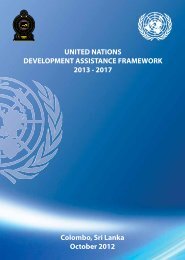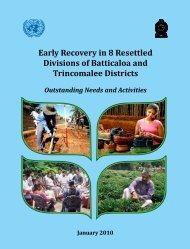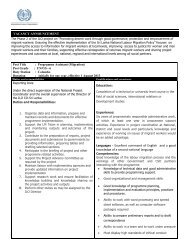Sri Lanka Human Development Report 2012.pdf
Sri Lanka Human Development Report 2012.pdf
Sri Lanka Human Development Report 2012.pdf
You also want an ePaper? Increase the reach of your titles
YUMPU automatically turns print PDFs into web optimized ePapers that Google loves.
Restrictive land ownership constrains agricultural<br />
productivity. The state owns 84 percent of land, of which<br />
34 percent is set aside for agriculture. Out of that, 48<br />
percent is leased to farmers under the Land <strong>Development</strong><br />
Ordinance permits, which do not provide full ownership<br />
rights (Figure 5.4). The lack of secure property rights<br />
negatively influences investment, access to credit,<br />
transferability and long-term usage patterns. People who<br />
cannot sell or lease land lose a safety net and the flexibility<br />
to move out of farming. 237 An additional problem is that<br />
existing legislation discriminates against women in the<br />
area of property rights (Box 5.2).<br />
services, access to markets, fertilizers, credit and so on.<br />
Much of the extent in smallholdings is located in the<br />
North Western, North Central and Southern provinces.<br />
A major share of extent in smallholdings is solely used for<br />
crop cultivation (73%). A much smaller share of land is<br />
used for livestock and crops mixed agriculture activities<br />
(Figure 5.5) 239 Only a very low amount of land is used<br />
only for livestock (0.1% of land extent under smallholding<br />
agriculture), a large portion of which is in the Northern<br />
and Western Provinces. 240<br />
Figure 5.4: State-Owned Land and the Redistribution of Agricultural Land<br />
Source: Institute of Policy Studies of <strong>Sri</strong> <strong>Lanka</strong> 2004.<br />
Note: The Mahaweli Ganga <strong>Development</strong> Programme is an integrated rural development programme undertaken based<br />
on water resources of Mahaweli and allied six river basins. Some land under the irrigation systems are vested with<br />
allottees with title deeds, and are termed Swarnaboomi grants. This allows under the Land <strong>Development</strong> Ordinance to<br />
develop the state land.<br />
Over the years, a land titling debate led to the 2008<br />
Registration of Title Act (RTA) No. 21. Implementation<br />
is difficult, as more than 39 operational laws and about<br />
60 institutions are involved in land administration and<br />
management, a situation fostering confusion over powers<br />
and duties, and lack of coordination. No mechanism exists<br />
to resolve conflicts. 238 Even so, land tenure can be less<br />
important to agriculture than other inputs, such as extension<br />
Cultivation is dominated by traditional crops that are less<br />
profitable than those with high-export value, such as palm<br />
oil, dragon fruits and horticultural crops. 241 Practiced on a<br />
wider scale and more intensively, diversification involving<br />
high-value crops could generate increased income and<br />
transform marginal operations into profitable ones. 242<br />
However, this does not seem feasible on a large scale at<br />
present because of poor access to water and technology.<br />
Chapter 5 Bridging <strong>Human</strong> <strong>Development</strong> Gaps: Employment and Livelihoods 87






